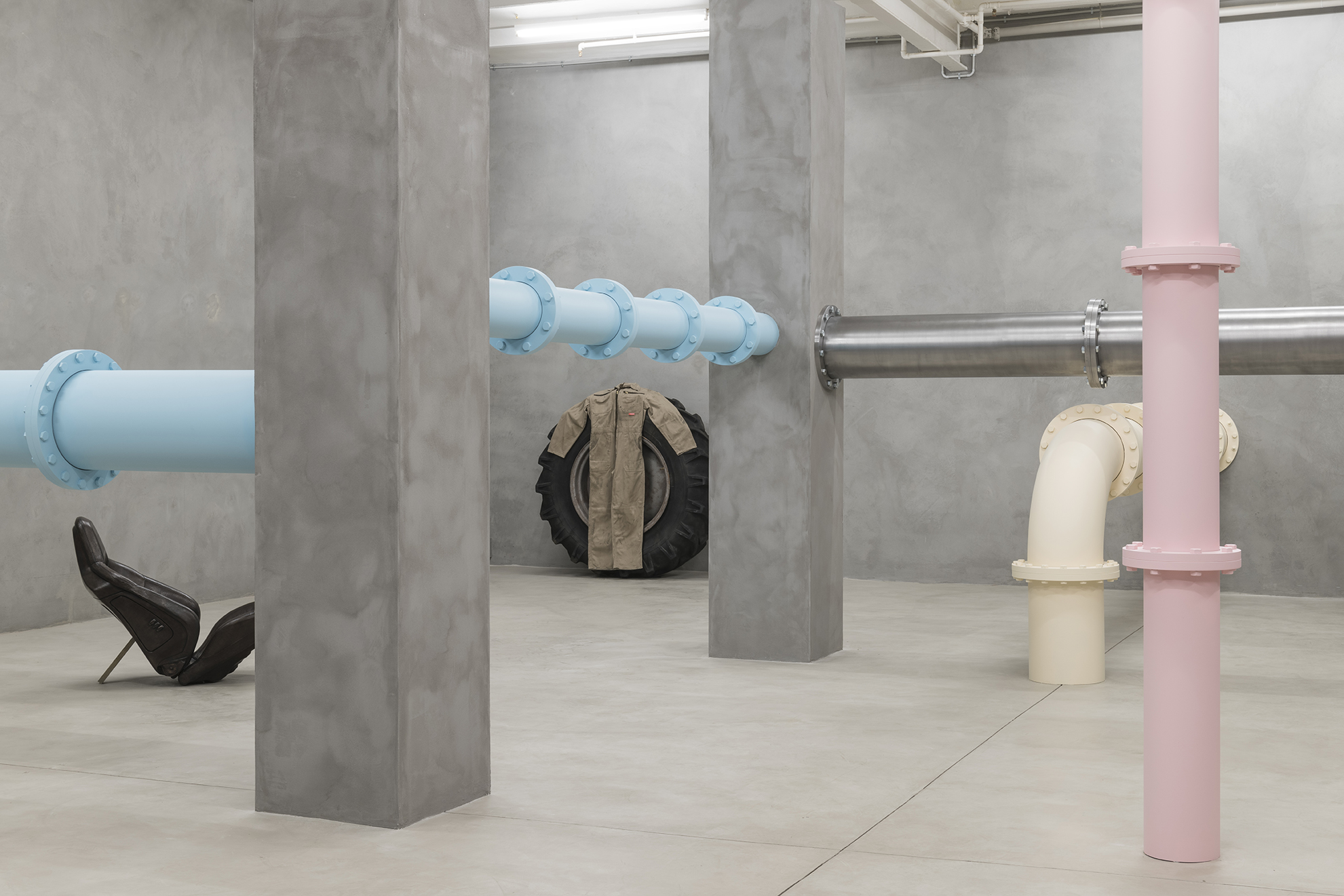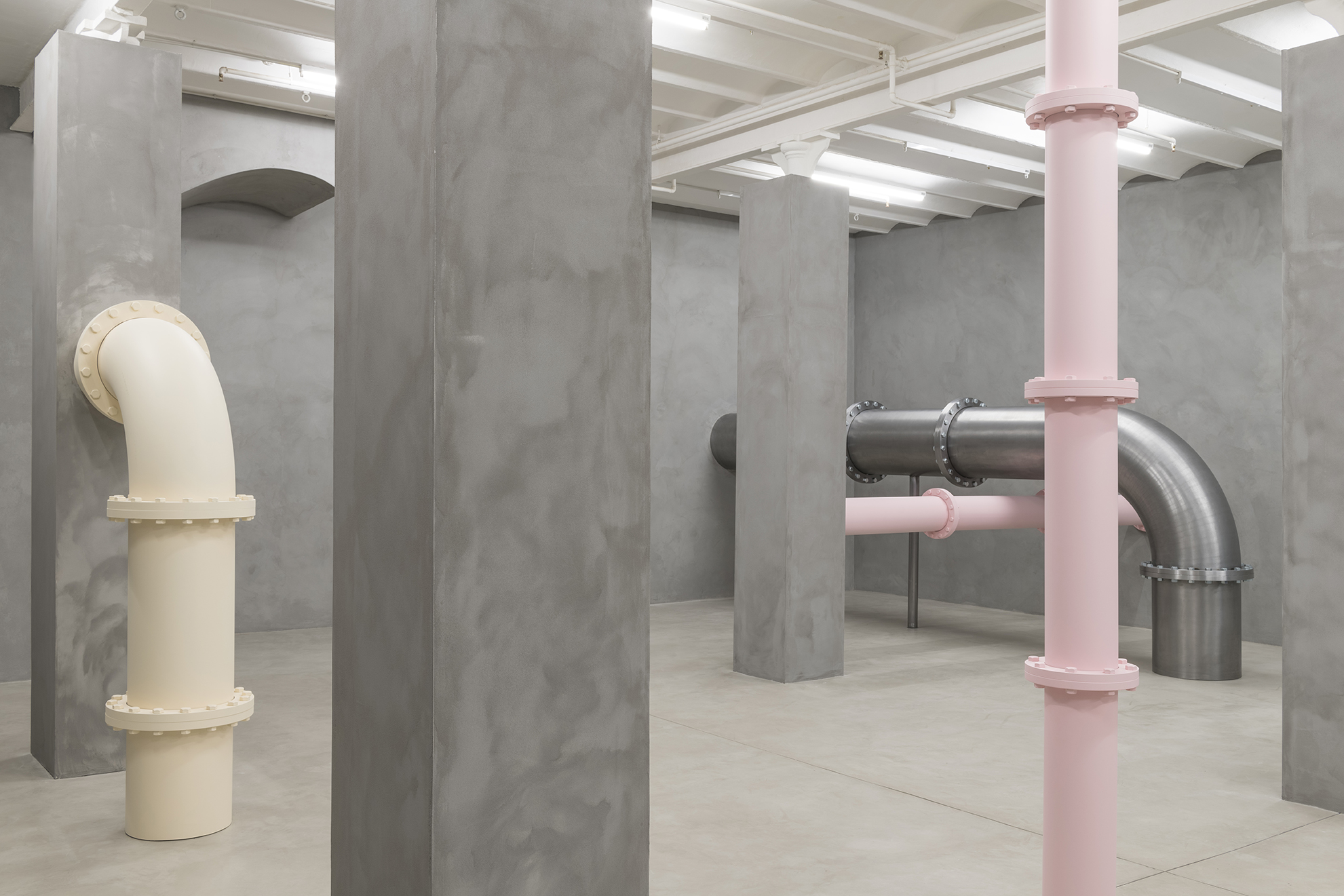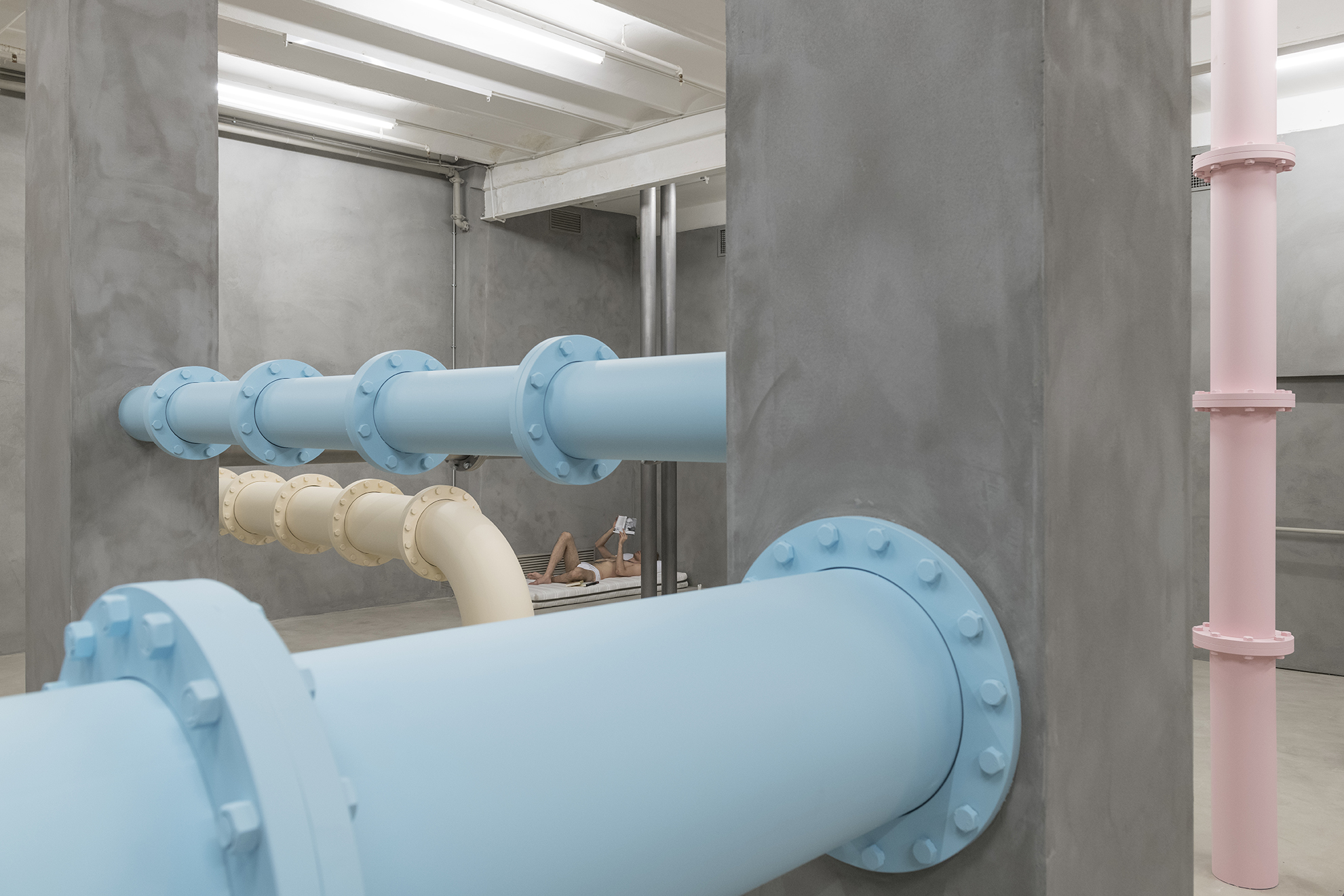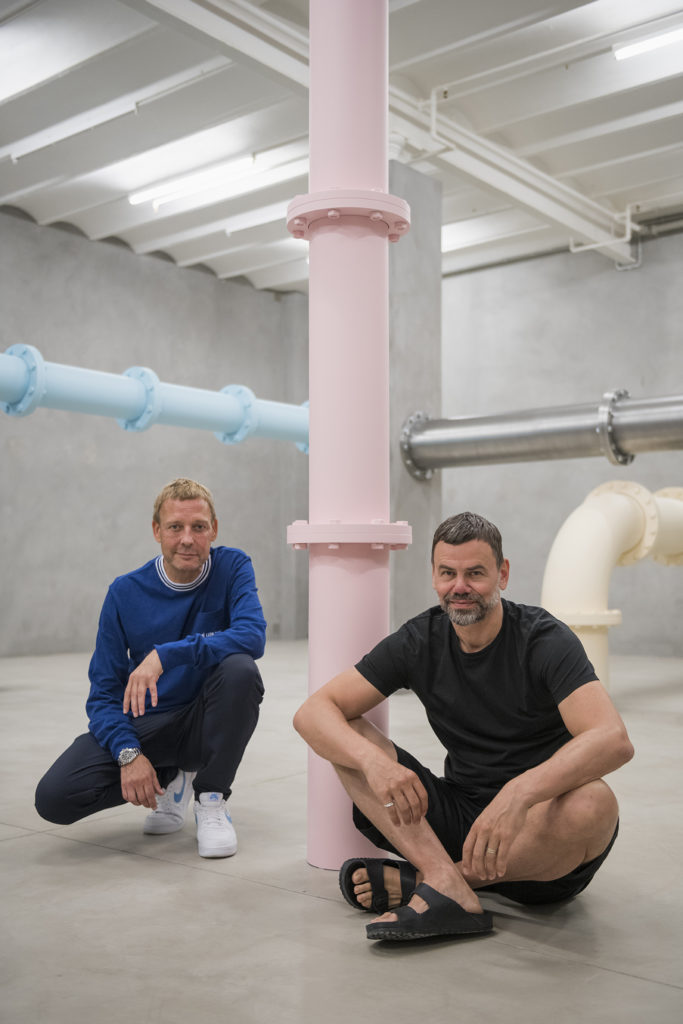Elmgreen & Dragset – It’s Not What You Think
 Based in Berlin, Michael Elmgreen (Danish, b. 1961) and Ingar Dragset (Norwegian, b. 1969) have been working together since 1995, redefining the format in which contemporary art is normally presented. Their installations, from sculptures to total environments, have included illusionistic experiments that change the perception of space, structures and architecture: galleries suspended by balloons, trampolines that jump into the imagination, unstable floors and upside-down rooms. The experiential element, together with a provocative and often narrative-led approach, plays a crucial role in their artistic language. The exhibitions of the Scandinavian duo – such as ‘The Welfare Show’ (Bergen Kunsthall, Norway, 2005), ‘The Collectors’ (53rd Venice Biennale, Italy, 2009), ‘Celebrity – The One & The Many’ (Museum für Neue Kunst am ZKM | Zentrum für Kunst und Medientechnologie, Germany, 2010-11) and ‘Tomorrow’ (Victoria & Albert Museum, UK, 2013) – explore the latest ideological changes within both individuals and society. In this interview we will deal with the exhibition ‘It’s Not What You Think’ – on view at Blueproject Foundation in Barcelona, through October 27 – in relation to their artistic practice.
Based in Berlin, Michael Elmgreen (Danish, b. 1961) and Ingar Dragset (Norwegian, b. 1969) have been working together since 1995, redefining the format in which contemporary art is normally presented. Their installations, from sculptures to total environments, have included illusionistic experiments that change the perception of space, structures and architecture: galleries suspended by balloons, trampolines that jump into the imagination, unstable floors and upside-down rooms. The experiential element, together with a provocative and often narrative-led approach, plays a crucial role in their artistic language. The exhibitions of the Scandinavian duo – such as ‘The Welfare Show’ (Bergen Kunsthall, Norway, 2005), ‘The Collectors’ (53rd Venice Biennale, Italy, 2009), ‘Celebrity – The One & The Many’ (Museum für Neue Kunst am ZKM | Zentrum für Kunst und Medientechnologie, Germany, 2010-11) and ‘Tomorrow’ (Victoria & Albert Museum, UK, 2013) – explore the latest ideological changes within both individuals and society. In this interview we will deal with the exhibition ‘It’s Not What You Think’ – on view at Blueproject Foundation in Barcelona, through October 27 – in relation to their artistic practice.
Francesca Filisetti: In the solo show at Blueproject Foundation a large site-specific installation turns the space into an underground, abandoned boiler room with industrial tubes of different colours and sizes crisscrossing the entire area. Could you reveal something on the genesis of this project? How did the space influence the design of the installation?
Elmgreen & Dragset: The Boiler Room was created in close dialogue with the space and architecture of the Blueproject Foundation. Architecture and context are often the starting point for our projects, and at the Foundation we immediately noticed the grey concrete walls and the orderly columns. They make the space feel industrial, different from a generic gallery space, so we thought: why treat it like a generic gallery? It reminded us of an underground environment, so we developed ideas in that direction. Boiler rooms are spaces that are dying out. With technological advances and less need for heavy industry in today’s world, there are a number of types of space that might even stop being incorporated into the designs of new buildings. Even now, a ‘boiler room’ is something people associate with DJ events rather than the actual space it refers to…
 FF: The pastel colours of the tubes appear at first glance innocent, even inviting, but actually correspond to the colour of the food pigments used to coat the pills of the new generations of anti-HIV drugs, such as Truvada, Atripla, Stribild and Isentress. Queer themes and the subject of AIDS have appeared throughout your career. How has your approach to these themes changed over the years? What is important to underline today about AIDS?
FF: The pastel colours of the tubes appear at first glance innocent, even inviting, but actually correspond to the colour of the food pigments used to coat the pills of the new generations of anti-HIV drugs, such as Truvada, Atripla, Stribild and Isentress. Queer themes and the subject of AIDS have appeared throughout your career. How has your approach to these themes changed over the years? What is important to underline today about AIDS?
E&D: Queer themes have run through our work since the beginning of our collaboration. We deal with topics relevant to us, so exploring those themes has been an intuitive part of our artistic approach. AIDS issues have informed and influenced so much of gay culture since the 1970s and 80s. It’s not talked about as much as it was during the AIDS crisis but that doesn’t mean that it has less of an impact on the way we interact, or on the way we approach relationships today. There’s still a kind of stigma or discomfort around it. Our works Side Effects (2015), that are being shown in ‘It’s Not What You Think,’ are glass jars filled with the pigments used to cover the latest generations of antiretroviral drugs such as Truvada or Isentress, as you mention. The jars are placed in combinations and sizes that correspond to the order of AIDS pills someone needs to take on a daily basis. The drugs look quite innocuous, almost candy-like, with these colours chosen by the pharma industry to disguise the fact that these medicines are pretty toxic and have a lot of side effects. Our artworks from this series remind us how many pills must be taken each day, every day, and what a big part of someone’s life living with AIDS can be.
FF: In addition, the shifting of the body from a system of production to an organ of consumerism for the pharmaceutical and entertainment industries is central to the show’s concept: the exhibition appears as a metaphor for the body as a biological and cultural product. This transformation of the body also involves an emotional and mental displacement. Could you comment on this complex issue – in relation to identity shaping?
E&D: Yes, the exhibition speaks about our relationship to our bodies – how it’s changing as we live in an increasingly technological world and especially in internet-based societies. The human body isn’t valued by industries for its physical abilities or skills as much as it used to be and we use our bodies physically less now than we probably ever have. Instead, we see them becoming more of a consumer target for fashion, or food, or health industries, whether through vital prescriptions to drug companies, or subscriptions to gyms, or fashion brands. The intestine-like pipes of our Boiler Room installation, however, distill this notion of the commodified body in such a technological age. Each pipe and its colour might indicate a different theoretical or literal function – so we can take a minute to ask ourselves: what does this physical bit do? This part here, this pipe or this organ… sort of reversing the displacement.
 FF: A performative dimension continuously pervades your projects – in this case let’s also think of Anywhere, the performance staged at the opening in Barcelona; however, sometimes it is the audience who (consciously or unconsciously) takes on the role of performer. It is particularly fascinating when the narrative is open to a different understanding depending on who the viewer is. Many young people came to visit the show and appropriated the scenario through new and subjective approaches, moving and betraying, in some cases, the “original” meaning. For example, some teenagers arrived with t-shirts of the same color as the tubes to take pictures and publish them on Instagram, inserting a fictitious place. This process of spontaneous appropriation could be at times exciting, at times annoying. I would like to know your opinion on this constant exchange of performances at stake.
FF: A performative dimension continuously pervades your projects – in this case let’s also think of Anywhere, the performance staged at the opening in Barcelona; however, sometimes it is the audience who (consciously or unconsciously) takes on the role of performer. It is particularly fascinating when the narrative is open to a different understanding depending on who the viewer is. Many young people came to visit the show and appropriated the scenario through new and subjective approaches, moving and betraying, in some cases, the “original” meaning. For example, some teenagers arrived with t-shirts of the same color as the tubes to take pictures and publish them on Instagram, inserting a fictitious place. This process of spontaneous appropriation could be at times exciting, at times annoying. I would like to know your opinion on this constant exchange of performances at stake.
E&D: Many of our artworks are now ‘Instagrammed’, like Prada Marfa (2005), our locked Prada boutique in the middle of the Texas desert. It was created before smartphones and selfie-culture existed, and since 2005 the public has propagated the reality of social media attractions themselves. Our artworks can take on a new life through a social media presence, which is interesting to see. In terms of performance though, is someone ‘performing’ in an artistic sense if they take a selfie in front of an artwork? How deep is the interaction with the artworks in such cases? It’ll be interesting to see how this behavior develops and is eventually written into history.
FF: In Anywhere, a boy was lying in a corner on a mattress reading some books such us Ciudad Princesa (Marina Garcés, 2018), La mejor parte de los hombres (Tristan Garcia, 2011) and Hojas de hierba (Walt Whitman, 1995). Can you explain a little more about this performance? Why are these particular objects included?
E&D: In the exhibition, there is a fictional narrative of a guy living in the boiler room, squatting even. A mattress and some books are left, and a used car seat seems to function as a temporary armchair. They are suggestive of a human presence, of human activity—someone living in the space but also not there entirely, a bit like a squatter. But in spite of this, nothing is really what it seems because, of course, the individual in the performance is a performer and not a real squatter. If you look a bit closer too, the objects aren’t quite as you’d expect: the burned-out candle is made of marble and bronze, and the car seat that might have been torn from an old Mercedes Benz is also cast in bronze, so things are slightly distorted. The books, like those in our performance in The Collectors in the Venice Biennale in 2009, are chosen by us. The performer can read and listen to music as they choose, occupying the space inside the boiler room, surrounded by objects that used to represent industry or production but now are slightly obsolete, like the car seat, or the coveralls and the tractor wheel that have no function in this context, without the tractor or worker present.
 FF: Keeping on talking about books, we would finally ask you about a personal selection. Could you share with us three books that you’d consider fundamental to recommend today to a young artist?
FF: Keeping on talking about books, we would finally ask you about a personal selection. Could you share with us three books that you’d consider fundamental to recommend today to a young artist?
E&D: Everyone should read more than three books! (laughing) Read broadly and keep an eye on what is going on.
